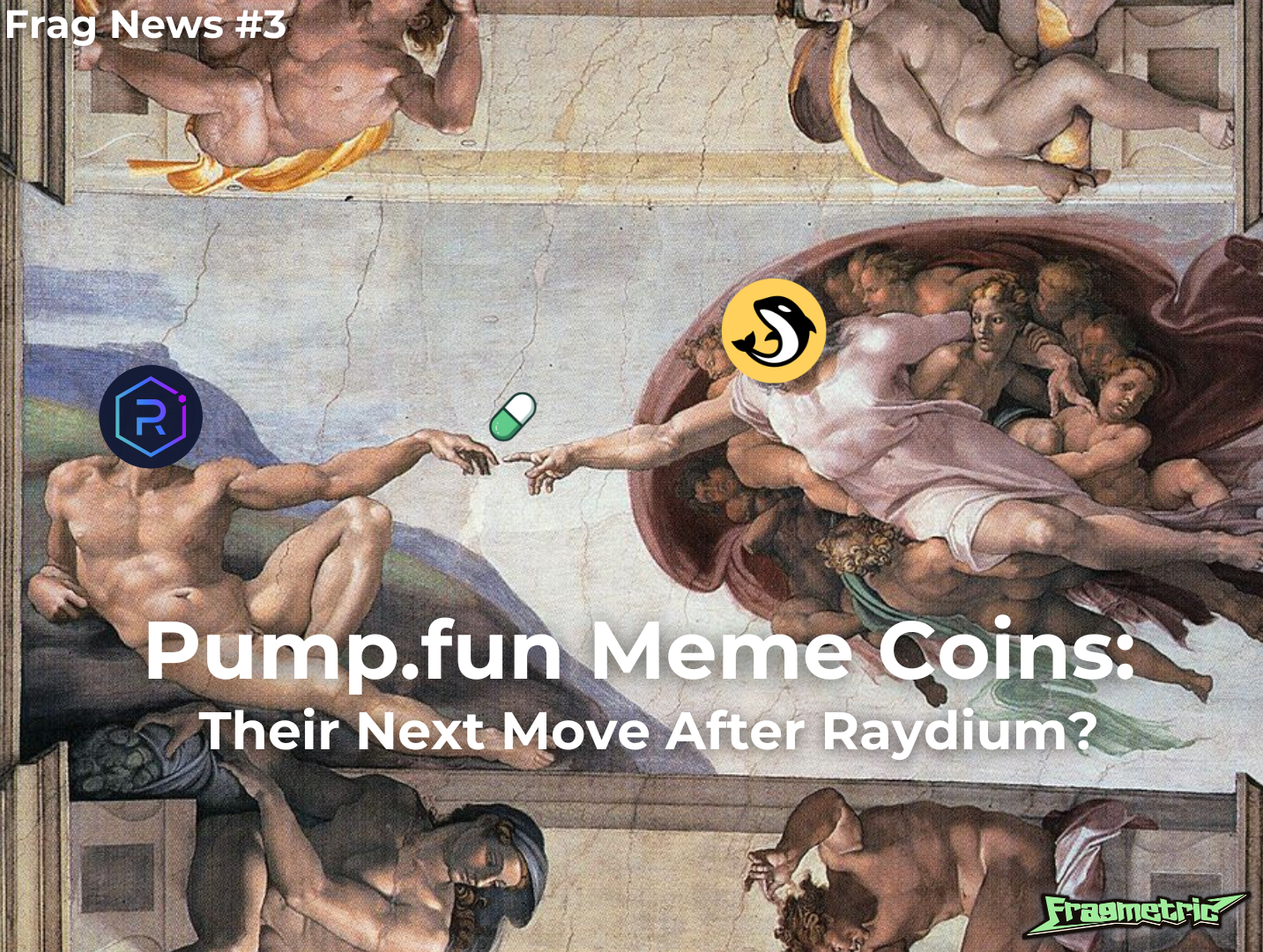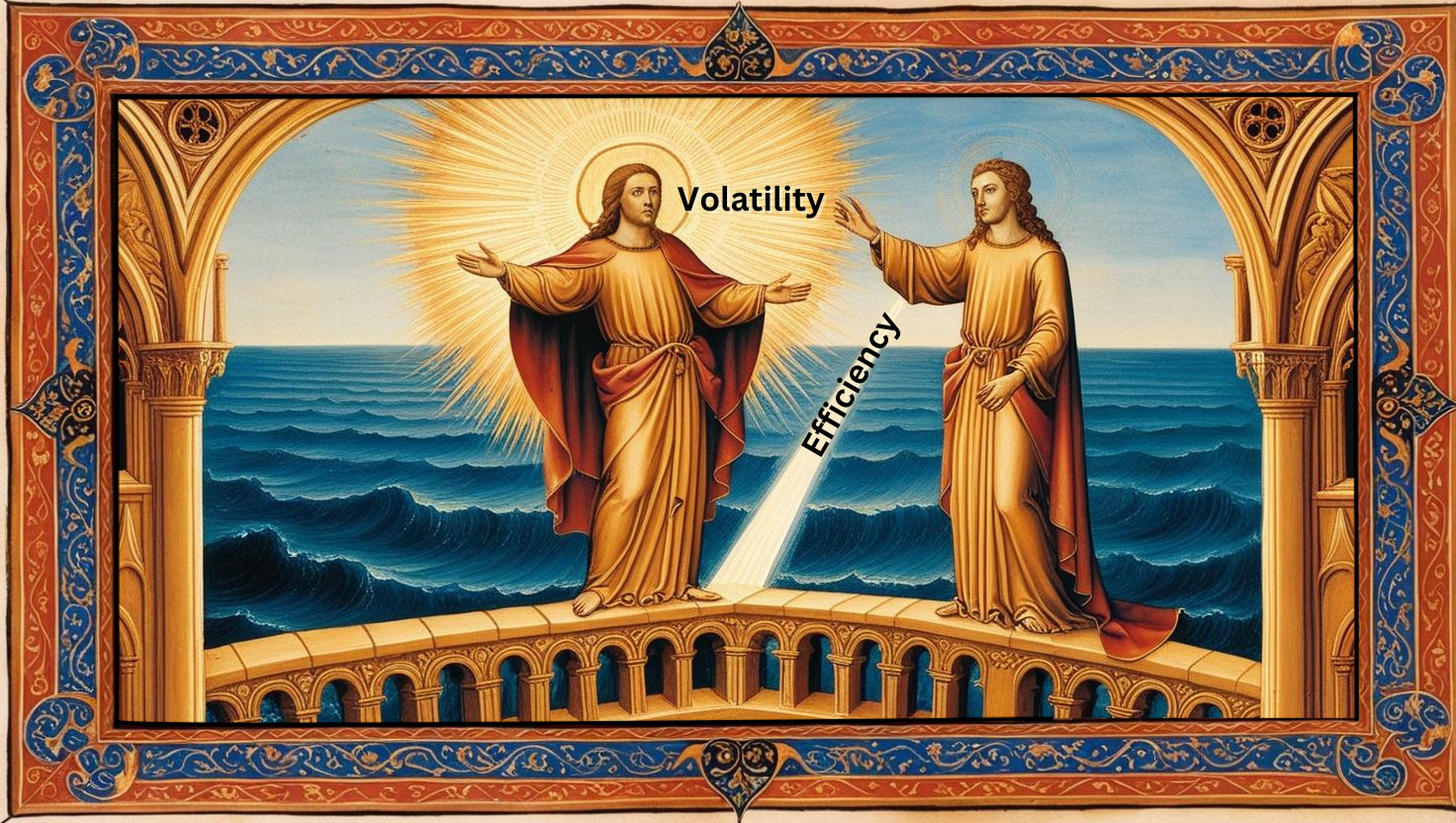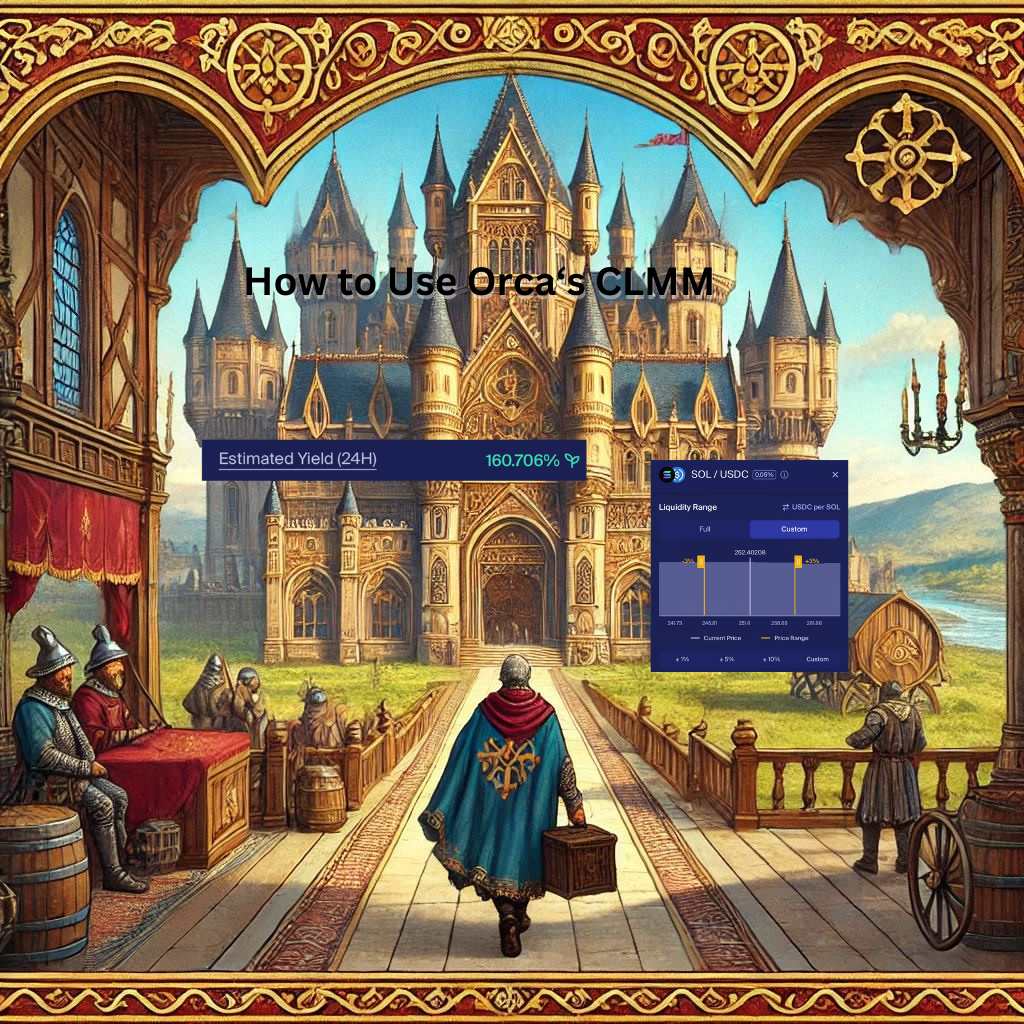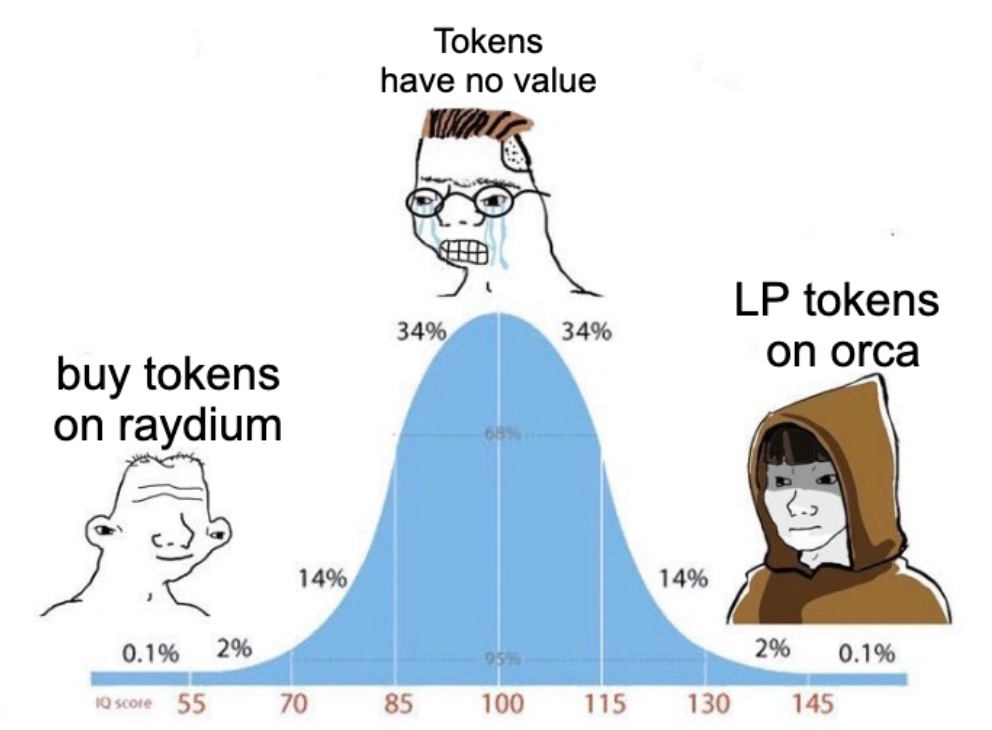
Earlier this year, Raydium teamed up with pump.fun to automatically create liquidity pools for meme coins that reached a certain market cap (~410SOL). This collaboration significantly boosted Raydium’s trading volume - In November 2024, 62.3% of all DEX transactions belonged to Pump.fun, according to Dune Analytics.
Pump.fun was monumental in bringing not only retail to onboard Solana, but a firestarter for a new subculture. It was a way to tokenize memetic culture in one click, support projects you’re bullish in, and fight in the trenches for early retirement. If you were a degen like me and habitually participated in the trenches, you often heard the phrase “Bond it to Raydium”. What does this mean? Why is it important? Pump.fun operates using a bonding curve model for each token issued. A bonding curve contract is a smart contract that uses mathematical formulas to set token prices based on supply and demand, creating a market independent of crypto exchanges. This gives the new token a chance to grow its market cap. Once, it gains enough size, $17k of liquidity is then deposited in Raydium and burned. This process is what we know as "bonding it to Raydium" and is a significant milestone for memecoins as they can now be traded in a larger scale, exposed to more traders. But now another question lies: why does Pump.fun deposit in Raydium and why do they burn the liquidity?
Raydium and Pump.fun: A Partnership for the Masses

Raydium is Solana's largest decentralized exchange (DEX). Unlike centralized exchanges, which utilizes an order book to manage offers from buyers and sellers, a decentralized exchange employs an algorithmic mechanism called an automated market maker (AMM) to automatically facilitate the trading. AMMs use liquidity pools, where tokens are deposited to provide liquidity. These pools then use algorithms to set token prices based on the ratio of assets in the pool. When a user wants to trade, they swap one token for another directly through the AMM, with prices determined by the pool's algorithm. Among the different types of AMMs, Pump.fun uses Raydium’s Constant Product Market Maker (CPMM), a type of AMM designed to ensure liquidity is always available by adhering to a simple formula: x⋅y=k. In this equation, x and y represent the quantities of the token pairs in the pool (often the bonded memecoin paired with SOL), and k is the constant product of x and y that remains fixed. Whenever someone trades one token for another, the formula adjusts the pool’s token ratios while keeping k constant. This mechanism ensures that no matter the trade size, liquidity is always accessible.
Additionally Pump.fun, locks deposited tokens permanently into the liquidity pool by burning the liquidity, meaning they can no longer be withdrawn. This approach ensures starting liquidity for memecoins, even in highly volatile markets. For traders, this guarantees that they can always buy or sell. CPMM is best for volatile, unpredicatable token pairs like memecoins that just bonded because the liquidity is spread equally across all price levels. Memecoins are very volatile, and we don’t know if it’ll go much higher, or retrace much lower. Memecoin's generally have low market caps, resulting in larger price fluctuations for every trade made. But once these coins grow in market cap, and become “relatively stable”, CPMMs start to lose efficiency. The price bands get a bit more predictable and the liquidity pools generally don’t need to cover the whole price range. For liquidity providers (LP) who are looking for better gains, they start to use another type of AMM called a Concentrated Liquidity Market Maker (CLMM).
The Evolution of Liquidity: From Volatility to Efficiency

A CLMM allows LPs to focus their liquidity within specific price ranges instead of spreading it equally across all prices, as seen in CPMMs. This targeted approach significantly increases capital efficiency since most trading activity occurs within predictable price bands. CLMMs still rely on the constant product formula, x⋅y=k, but only within each tick—a defined price range set by the LP. By splitting the liquidity pool into these discrete ticks, CLMMs create a piecewise constant product curve, allowing for more precise management of token reserves and liquidity. For example, the liquidity and price bounds of a tick can be used to derive token reserves and replicate the behavior of traditional AMMs within that range. CLMMs often represent positions as NFTs, making them customizable and tradable. By concentrating liquidity, LPs can earn higher fees from trades within their chosen range, but this comes with added responsibility: if the market price moves outside their range, their position becomes inactive, earning no fees until adjusted. Though Raydium is the number one CPMM in Solana, the go-to CLMM that most users gravitate to is another DEX called Orca. Orca was the first DEX to utilize the CLMM model on Solana, providing tools to help users manage their liquidity and maximize efficiency.
Raydium’s CPMM is ideal for volatile and unpredictable tokens, like newly bonded memecoins, as it spreads liquidity across all prices. However, once these tokens escape the trenches and move out of their price discovery phase(ideally reaching a stable multi-million market cap) liquidity provision through Orca’s CLMM becomes more efficient. CLMMs allow users to predict price bands and concentrate liquidity within those ranges, maximizing returns while reducing inefficiencies. This transition marks a strategic evolution in the token’s lifecycle, from the broad liquidity of Raydium to the precision of Orca.
Orca is the leading CLMM on Solana and the second-largest DEX after Raydium. Its importance in the DeFi ecosystem is clear from its metrics: over $XXXX in fees were generated in the past 24 hours alone, with its most popular pools being XXXX. Orca’s CLMM offerings are diverse, catering to a wide range of liquidity needs. From memecoin pairs like BONK-SOL to stablecoin pairs like USDC-SOL, and even LST pairs like jitoSOL-SOL, Orca supports users in managing their liquidity more effectively. In the near future, LRT pairs like fragSOL-SOL could also be created, further enhancing the ecosystem. By aligning liquidity provision with anticipated exchange rates, CLMMs like Orca enable liquidity providers to consistently and efficiently earn fees. In fact, the majority of liquidity for LSTs and stablecoins on Solana are provided by CLMMs like Orca.
Entering the Realm: Navigating the Flow of Opportunity

For a lot of newcomers, it may feel daunting to learn how to use Orca. However, once you understand a few key points, it becomes relatively simple. When providing liquidity in Orca’s CLMMs, understanding the dynamics of your chosen asset pair is critical.
- Stablecoin pairs exhibit low volatility, allowing LPs to concentrate liquidity within tighter ranges to maximize fee earnings from predictable trades. For newcomers, stablecoin pairs are an excellent starting point to test strategies with minimal risk.
- In contrast, volatile pairs like BONK-SOL require broader ranges to accommodate unpredictable price movements. Although riskier, these pairs offer higher fees, rewarding LPs for managing liquidity in active markets.
To use Orca effectively, start by analyzing the pool’s current price and volume trends. Concentrated liquidity pools depend on accurate positioning—if the price moves outside your defined range, your position becomes inactive, earning no fees. For stablecoin pairs, position liquidity near the current market price with narrower ranges (e.g., ±2%). For volatile pairs, consider wider ranges (e.g., ±15%) to account for significant price fluctuations while still capturing trading fees.
Active Management: Risk and Rewards. {possibly image of scale medieval person in a market or something}

Active management is key to maximizing returns. Regularly monitor your position and rebalance as needed when the price approaches the edges of your range. For LPs managing volatile pairs, dynamic strategies like multiple overlapping ranges can provide continuous coverage while capturing higher fees during sharp price movements. Fortunately, Solana’s low transaction costs make frequent rebalancing cost-effective compared to other blockchains like Ethereum.
Another critical tip is to carefully review your custom ranges during setup. Orca’s interface allows you to define ranges through sliders, presets, or manual inputs, giving you flexibility in tailoring your position. Misaligned ranges can lead to inefficiencies or losses, so ensure the chosen range aligns with the asset’s historical price behavior and your risk tolerance. When deploying capital, keep in mind that narrower ranges offer higher efficiency but require more frequent adjustments, while wider ranges are more forgiving but generate slightly lower returns per trade.
For advanced users, adopting meta-strategies like directional bets or 50/50 splits can further enhance returns. For instance, concentrating liquidity slightly above or below the current price can position you to capitalize on anticipated market movements. Meanwhile, stablecoin pairs benefit from simple, evenly distributed ranges that minimize risk.
For users looking to farm points with minimal risk, LST-SOL or LRT-LST liquidity pools are an excellent option. Unlike volatile memecoin-USDC pairs, where price swings can lead to significant impermanent loss, these pools are inherently more stable. This stability comes from the fact that the value of an LST (such as wfragSOL) is closely tied to SOL, as it represents SOL plus staking rewards, MEV rewards, and NCN rewards. As a result, wfragSOL consistently trades above SOL due to its accrued yield, reducing the risk of price divergence between the paired assets.
Because of this, providing liquidity to LST/LRT pools is easier to manage and offers a safer way to earn rewards. Additionally, if these pools are incentivized with point boosts or token emissions, they become an even more attractive option for users seeking passive yield in DeFi. Fragmetric’s recent integration with Orca enables users to supply liquidity to wfragSOL-JitoSOL and wfragJTO-JTO pools, allowing them to earn both restaking yields and trading fees. This is a straightforward yet effective strategy for maximizing returns.
On top of that, liquidity providers in the wfragSOL-JitoSOL and wfragJTO-JTO pools benefit from a 2x fpoint boost. This means that if a user supplies 1 wfragSOL and 1 JitoSOL, the system approximately counts it as 4 wfragSOL worth of fpoint boosts, significantly amplifying their rewards.
Lastly, always secure your liquidity position NFT. The NFT symbolizes your pool position and burning or losing it results in irrecoverable loss of funds. Orca provides the tools, but effective liquidity provision ultimately depends on informed decision-making and active participation.
Conclusion

Raydium and Orca each have their strengths: Raydium’s broad liquidity is perfect for volatile memecoins, while Orca’s targeted CLMM approach brings efficiency and precision to liquidity provision. Either way, both are building the foundation for seamless swapping and liquidity. It’s thanks to those pools that swapping tokens is kept decentralized, secure and simple as a click.
Join the Fragmetric Community
- website : fragmetric.xyz
- Read through the documentation : docs.fragmetric.xyz
- Meet the community in Discord : discord.gg/fragmetric
- Follow @fragmetric on X : x.com/fragmetric
About Fragmetric:
Fragmetric is a native liquid (re)staking station on Solana that aims to improve the economic potential and security of the Solana ecosystem. Fragmetric succeeded in carrying out NCN reward distribution by utilizing Solana's token extension. Additionally, Fragmetric created useful solutions, such as the Normalized Token Program, for utilizing various LSTs in restaking platforms. The goal of Fragmetric is to create a safe, open, and incredibly effective restaking system that empowers users and supports the stability of the Solana restaking ecosystem.










 Go back
Go back